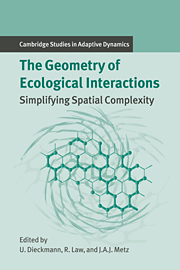Book contents
- Frontmatter
- Contents
- Contributing Authors
- 1 Introduction
- Part A Empirical and Statistical Background: A Plant Ecological Perspective
- Introduction to Part A
- 2 A Neighborhood View of Interactions among Individual Plants
- 3 Spatial Interactions among Grassland Plant Populations
- 4 Spatio-temporal Patterns in Grassland Communities
- 5 Statistical Modeling and Analysis of Spatial Patterns
- Part B When the Mean-field Approximation Breaks Down
- Part C Simplifying Spatial Complexity: Examples
- Part D Simplifying Spatial Complexity: Techniques
- References
- Index
- International Institute for Applied Systems Analysis
2 - A Neighborhood View of Interactions among Individual Plants
Published online by Cambridge University Press: 14 January 2010
- Frontmatter
- Contents
- Contributing Authors
- 1 Introduction
- Part A Empirical and Statistical Background: A Plant Ecological Perspective
- Introduction to Part A
- 2 A Neighborhood View of Interactions among Individual Plants
- 3 Spatial Interactions among Grassland Plant Populations
- 4 Spatio-temporal Patterns in Grassland Communities
- 5 Statistical Modeling and Analysis of Spatial Patterns
- Part B When the Mean-field Approximation Breaks Down
- Part C Simplifying Spatial Complexity: Examples
- Part D Simplifying Spatial Complexity: Techniques
- References
- Index
- International Institute for Applied Systems Analysis
Summary
Introduction
In no area of ecology is the role of space more fundamental than in the study of plant communities (Hutchings 1986; Crawley and May 1987). Individual plants are rooted in one place and their ability to move and occupy space is restricted to growth (Eriksson 1986). A plant cannot relocate from an unfavorable location to a more favorable one. Rather, it grows as well as possible where it finds itself or it dies. Basic plant biology suggests that plant–plant interactions are inherently local in nature. For example, individual plants do not experience global population density per se, but only interact with neighbors over restricted distances. The mobility of animals makes their spatial behavior potentially far more complex than that of plants, but, ironically, this ability to move can make the modeling of space for animal populations unnecessary in many cases. For example, because animals can “diffuse” in space from areas of higher density to areas of lower density, models based on mean spatial behavior or overall density may often be sufficient. Because a plant's ability to move is quite restricted (except during dispersal), local conditions are of much greater significance to plants than to animals. When feeding fish in a tank, it does not matter where on the water surface one places the food, because the fish will come to it. But when watering or fertilizing the garden one must make sure that the resource comes close to the plant – if one waters only half the garden the other half will not obtain sufficient water.
- Type
- Chapter
- Information
- The Geometry of Ecological InteractionsSimplifying Spatial Complexity, pp. 11 - 27Publisher: Cambridge University PressPrint publication year: 2000
- 87
- Cited by



